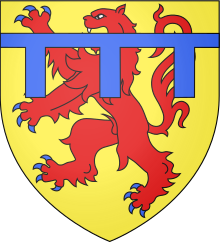Brederode

The lords and barons (later also imperial counts ) of Brederode were the noblest noble family of Holland in the Middle Ages , who came from the lords van Teylingen from an illegitimate sideline of the Dutch counts from the house of the Gerulfingers . The main line died out in 1679, a bastard line that had existed since the end of the 18th century existed until 1832.
history
Dirk van Teylingen -Brederode (approx. 1180–1236), who was the first "Lord of Brederode" and acted as the Drost of the Dutch counts, is the progenitor of the family . From then on, his descendants named themselves after their manorial seat Schloss Brederode .
The Lords of Brederode already had a huge influence in the 13th century. Wilhelm von Brederode was (around 1282) the builder of Brederode Castle near Santpoort, municipality of Velsen, North Holland . Their support for Johann von Avesnes was not without significance, but this increased when the dispute between the Hoeks and the cod broke out ( hook and cod war , 1351). The Brederodes were the hereditary leaders of the Hoeks, the Noble Party and the Arkels and Egmonts , the rival families, their opponents.
Under Duke Wilhelm of Bavaria (1365–1417) Wolrad (Walram) von Brederode (1370–1417) acquired the title of Count of Gennep and the sovereign rule of Vianen . He fell in the victorious battle of Gorcum as a general of Countess Jacobäa von Hainaut-Zeeland-Holland (1401-1436), the daughter of Wilhelm.
Wolrad's grandson Rainald II (1415–1473) became the hereditary burgrave of the city of Utrecht , and from then on the Brederodes remained entangled in their uninterrupted civil disputes . Rainald's brother was the temporary bishop of Utrecht Gijsbrecht van Brederode (1416-1475).
Rainald's second son was Franz van Brederode (1466–1490), who, while still very young, was raised by the discontented Dutch nobles to become the leader of the reviving Hoeks. He led a two-year civil war (1488-1490) in Holland and Zeeland , which mainly consisted of the siege of the two fortresses of Rotterdam , which Franz conquered in 1488, and Sluis in Dutch Flanders . It was the last open battle of the Dutch nobility against the Burgundian-Austrian government and its newer ideas. Franz succumbed to his wounds after taking Sluis in 1490, at the age of only 24.



The Brederodes, high-spirited because of their steadily growing possessions, their high reputation and their quasi princely dignity, were always characterized by their pride. But especially Rainald III. who, under Charles V, laid claim to the county of Holland and therefore lost all his dignities and possessions as a high traitor. Since his claims never had any real weight, he got them back from the emperor.
Rainalds III. second son was Heinrich , Graf von Brederode (1531–1568), the leader of the allied Dutch nobles, the so-called Compromis des Nobles of 1566 and the Geusen . Socially, he stood between the high nobility and the lower nobility and was therefore very suitable for this task of mediator. A year later, the Catholic Count von Megen temporarily conquered his ancestral seat at Kasteel Batestein in Vianen . Heinrich died in exile at Horneburg Castle near Recklinghausen . Reinald III. also had an illegitimate son, Lancelot von Brederode , who was also a Geusenführer.
The main branch of the family continued for about 150 years, always in high esteem and held high positions and offices in the state and the army. The penultimate scion, Johann Wolfart von Brederode , Field Marshal of the Republic of the United Netherlands, took the first position in the same after 1650, due to his rank, his wealth and his marriages, first with a Countess of Nassau , later with Ludowika Christina von Solms -Braunfels (1606–1669), Amalia's sister (1602–1675), wife of Friedrich Heinrichs von Oranien (1584–1647), heir to the Netherlands. His numerous offspring quickly died. His last son Wolfart, who was also the last Count of Brederode, died in 1679. After his death, Brederode Castle fell to the States of Holland .
The glory of Vianen passed through inheritance to the illegitimate descendants of Reinoud III. van Brederode (1492–1556), the so-called Lords of Bolswaert , and the Batestein Castle there burned down in 1696 and was razed. Emperor Joseph II awarded the Lords of Bolswaert the title of " Imperial Count of Brederode". In 1832, the last Reich Count of Brederode from the Bolswaert line died.
Furthermore, a non-aristocratic line of the Brederode family still exists today. This line can be traced back to Dirk Walravensz van Brederode, who was a later legitimized son of Walraven van Brederode († 1369), the younger brother of Reinoud I. van Brederode .
Individual evidence
literature
- PL Müller: Brederode . In: Allgemeine Deutsche Biographie (ADB). Volume 3, Duncker & Humblot, Leipzig 1876, pp. 279-281. (Family item)
- Detlev Schwennicke : European Family Tables , Volume XVIII (1998), Plate 39/40 (Genealogy of the Lords of Brederode)

